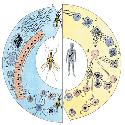Long, depressing, but all too familiar story...
But, made as short as possible, after reading many discussions here, I changed my philosophy to "Quarantine, observe and treat if anything identified." I had no problems, and never saw any spots, etc despite observing all additions for a 3 weeks and all were eating.
All was well until my ATO went out, and I did not noticed for several days, causing my tank to become very high in specific gravity (1.027.) I stupidly dumped RO water into the tank to bring the water up to level in the sump, and went to bed.
Woke up the next morning to a dead tang, and several other fish obviously covered in velvet. Before I could get the QT set up, all of those were dead (Clown I've had for 10 years, PJ Cardinal, Foxface Lo.)
Everyone in the tank died except for an Diamond Goby, who is still cruising the tank, refusing all attempts at retrieval. Eating happily, looking around going, "Where did everyone go" while sifting the sand throughout the tank.
I have heard of ich being "dormant" (hence ich management) but not velvet. How would you treat the goby, knowing if not infected, obviously a carrier of tomonets?
But, made as short as possible, after reading many discussions here, I changed my philosophy to "Quarantine, observe and treat if anything identified." I had no problems, and never saw any spots, etc despite observing all additions for a 3 weeks and all were eating.
All was well until my ATO went out, and I did not noticed for several days, causing my tank to become very high in specific gravity (1.027.) I stupidly dumped RO water into the tank to bring the water up to level in the sump, and went to bed.
Woke up the next morning to a dead tang, and several other fish obviously covered in velvet. Before I could get the QT set up, all of those were dead (Clown I've had for 10 years, PJ Cardinal, Foxface Lo.)
Everyone in the tank died except for an Diamond Goby, who is still cruising the tank, refusing all attempts at retrieval. Eating happily, looking around going, "Where did everyone go" while sifting the sand throughout the tank.
I have heard of ich being "dormant" (hence ich management) but not velvet. How would you treat the goby, knowing if not infected, obviously a carrier of tomonets?






















